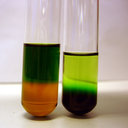Toward the Reconstitution of a Two-Enzyme Cascade for Resveratrol Synthesis on Potyvirus Particles.
Avainsanat
Abstrakti
The highly ordered protein backbone of virus particles makes them attractive candidates for use as enzyme nano-carriers (ENCs). We have previously developed a non-covalent and versatile approach for adhesion of enzymes to virus particles. This approach makes use of z33, a peptide derived from the B-domain of Staphylococcus aureus protein A, which binds to the Fc domain of many immunoglobulins. We have demonstrated that with specific antibodies addressed against the viral capsid proteins (CPs) an 87% coverage of z33-tagged proteins can be achieved on potyvirus particles. 4-coumarate coenzyme A ligase (4CL2) and stilbene synthase (STS) catalyze consecutive steps in the resveratrol synthetic pathway. In this study, these enzymes were modified to carry an N-terminal z33 peptide and a C-terminal 6xHis tag to obtain (z)4CL2(His) and (z)STS(His), respectively. A protein chimera, (z)4CL2::STS(His), with the same modifications was also generated from the genetic fusion of both mono-enzyme encoding genes. All z33 enzymes were biologically active after expression in Escherichia coli as revealed by LC-MS analysis to identify resveratrol and assembled readily into macromolecular complexes with Potato virus A particles and α-PVA CP antibodies. To test simultaneous immobilization-purification, we applied the double antibody sandwich - ELISA protocol to capture active z33-containg mono-enzymes and protein chimera directly from clarified soluble cell lysates onto the virus particle surface. These immobilized enzymes were able to synthesize resveratrol. We present here a bottom up approach to immobilize active enzymes onto virus-based ENCs and discuss the potential to utilize this method in the purification and configuration of nano-devices.


